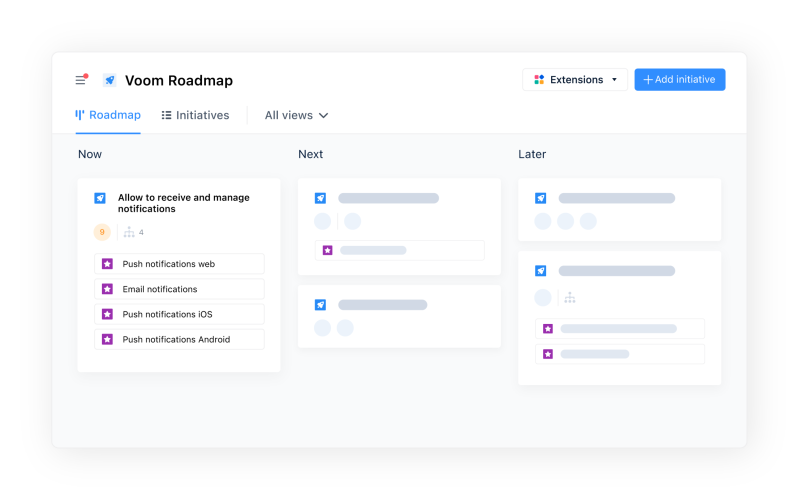
It is October 1, 2022.
Apple has just released iPhone 14 last month amid disappointment from fans who were expecting more upgrades than the regular camera, performance and OS updates.
In a new planetary defense effort following the script of an all-time Hollywood blockbuster and Bruce Willis movie “Armageddon”, NASA also announced last month the successful test of their asteroid deflection technology (mission Dart).
In another NASA-related news, the photographs from the newly deployed James Webb telescope sent everyone into a frenzy and became wallpapers on many desktops.

With the year coming to a close, many product teams were busy crafting their multi-year roadmaps, outlining a carefully curated list of features and enhancements to keep their products at the cutting edge of innovation.
These roadmaps were supposed to serve as guiding beacons, directing the efforts of engineers, designers, and marketers towards a shared vision of what the future held.
Fast forward two months. It is November 30, 2022.
OpenAI pilots its new language model, called ChatGPT, that can answer questions and assist you with tasks, such as composing emails, essays, and code.
In less than 2 months, ChatGPT would go on to acquire 100 million users and change the tech world as we know it.
As the tech industry grappled with the transformative power of ChatGPT, feature roadmaps that had once guided the strategic direction of countless companies now found themselves rendered useless.
The emergence of generative AI capabilities demanded a fundamental shift in priorities, forcing every company to make room for this groundbreaking technology.

Best practices for Roadmapping
A product roadmap serves as a strategic blueprint that guides the development, evolution, and success of a product. It outlines the vision, goals, and features that will be delivered over time. However, creating an effective product roadmap can be really challenging. It requires careful planning, collaboration, and consideration of various factors.
When creating a product roadmap, it is often very easy to get caught up with low level details i.e. features. Setting clear and measurable goals that align with the overall business strategy forms the basis of effective roadmapping. Each feature or initiative on the roadmap should then tie back to these goals. For example, Apple's differentiation strategy has always been to gain a competitive advantage over its competitors by adopting a consumer-first mindset by focusing on user experience, innovation, and improving performance. With this in mind, Apple included features like Face ID, Siri, Apple Pay etc in their iPhones that has allowed Apple to achieve its goals.

To create an effective product roadmap, managing changing priorities is crucial, but it can be challenging due to difficulties in maintaining strategic goals' focus, resource allocation conflicts, and effective stakeholder communication. Premature convergence on including features in the roadmap, over goals, can make your roadmap rigid because of obligations to the stakeholders. Your understanding of the customer problem, as well as the technology available to you to solve those problems, will change over time and is therefore bound to reset your roadmap. Having goals as the basis of the roadmap can allow you to remain flexible and pivot wherever necessary.
Balancing short-term versus long-term goals requires careful consideration of the trade-offs between immediate customer needs and long-term strategic objectives. A well-balanced product roadmap will prioritize short-term goals that complement long-term goals, adapt to changing conditions, and provide a clear direction for the product's future.
In today’s fast paced technological times, Big Tech companies disrupt several industries every year. In the last year’s WWDC event alone, Apple apparently put a number of companies at risk with a number of announcements:
Buy Now, Pay Later capability
Tap to pay
Visual Collaboration app
Passwordless access to apps
Therefore, when creating roadmaps, product companies should also focus on building long-term ‘moats of protection’ to build a sustainable competitive advantage and avoid getting disrupted because features can easily be copied. Companies like Nike and Apple have built ‘Brand Loyalty’ with its customers which is hard to mitigate by their competition. Social media platforms like Facebook, Instagram, Whatsapp rely on ‘Network Effects’ to compete against new entrants. Amazon has its ‘Economies of Scale’, Netflix and other Marketplace apps have their ‘Exclusive’ content, and Microsoft has built an eco-system of its product offerings (Office 365 Suite) that makes it really difficult for its customers to switch, despite better standalone products from the competition like Slack.
Balancing internal stakeholder recommendations with customer feedback adds another layer of complexity, as customer needs and desires may not always align with internal goals. Internal stakeholder recommendations often come from various departments, each with their own priorities and objectives, making it difficult to align and reconcile their diverse perspectives. Additionally, addressing defects and technical debt poses a constant challenge as they require dedicated resources and time, which may compete with new feature development. Striking the right balance between these competing priorities requires careful analysis, strategic decision-making, and effective communication to ensure that the product roadmap aligns with both internal and external stakeholders' needs while maintaining a healthy product ecosystem.

A flexible product roadmap that prioritizes tasks based on their impact, transparently communicates changes to stakeholders, and prioritizes customer needs can address these challenges. Most teams often split the roadmap into core features, customer feedback, defects & Tech debt, and disruptive innovations, respectively. Finding that split ratio is crucial when creating roadmaps, as it enables a balanced allocation of resources. Google follows a golden ratio of 70/20/10 for their products - dedicating 70% towards core features and enhancements, 20% for addressing customer feedback, defects and technical debt, and the remaining 10% for disruptive innovation bets.
Check out airfocus's product roadmap template.
When it comes to creating an effective product roadmap, there are several tools and software available that can streamline the process and enhance collaboration. One popular option is airfocus, which provides a comprehensive platform for prioritizing features, visualizing roadmaps, and aligning teams around product strategy. JIRA, Asana, Trello and Roadmunk are other valuable tools that offer an ability to track roadmap progress and dependencies. These tools empower teams to streamline their roadmap processes, enhance collaboration, and effectively manage the complexities of product development, while ensuring that stakeholders are well informed.

Airbnb Case Study
When the pandemic hit, Airbnb's business was severely impacted, with many cancellations and a drop in demand. The company had to pivot quickly and come up with a new strategy to address the situation.
Airbnb's product team developed a three-stage roadmap to help the company weather the storm.
Stage 1: Survival Mode
During the first stage, which began in March 2020, Airbnb focused on survival by taking immediate steps to cut costs and conserve cash. The company laid off 25% of its workforce, suspended all marketing activities, and cut executive salaries. In addition, Airbnb raised $1 billion in debt and equity financing to focus on measures such as offering flexible cancellation policies, waiving fees, and providing more incentives to hosts and guests.
Stage 2: Stabilization Mode
In the second stage, which began in the second half of 2020, Airbnb focused on stabilization by adapting to the new travel landscape. The company shifted its focus to domestic travel, where it saw an increase in demand as people looked for nearby getaways. Airbnb also introduced new features such as Online Experiences to cater to customers who were looking for virtual experiences from home. In addition, the company implemented enhanced cleaning protocols to address the health and safety concerns of guests.
Stage 3: Growth Mode
In the third stage, which began in late 2020 and continued into the majority of 2021, Airbnb focused on growth by capitalizing on the recovery of travel. The company expanded its offerings by adding new categories such as transportation and experiences, as well as introducing new tools to help hosts manage their listings more efficiently.
Overall, Airbnb's three-stage product roadmap was successful in helping the company navigate the pandemic and emerge stronger on the other side. It demonstrates the importance of having a clear strategy and a flexible approach to product development in response to unexpected challenges.

Netflix Case Study
When Gibson Biddle joined Netflix in 2005 as VP of Product, he sought to build a roadmap by brainstorming potential ideas with all the stakeholders. He created a laundry list of all the backlog items, customer feedback, support tickets and internally generated ideas and used his own prioritization method to craft the roadmap for the next four quarters. The prioritization technique, called the DHM model, sought to answer the question:
“How will the feature delight customers, in hard-to-copy, margin-enhancing ways?”
The roadmap exemplifies the power of embracing customer-centricity, building long-term competitive advantage, while also focusing on immediate business needs. As other companies strive to emulate Netflix's success, they can draw inspiration from the streaming giant's commitment to continuous improvement, customer focus, and staying ahead of the curve through agile roadmap planning.

Netflix’s roadmap – as taken from Gibson Biddle’s Product Strategy blog on Medium.

Sami Rehman

Read also






Build great roadmaps

Experience the new way of doing product management



